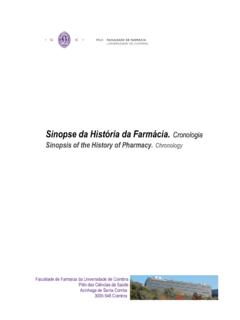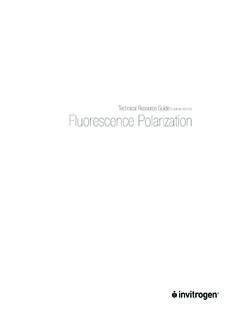Transcription of FLUORESCENCE MOLECULAR IMAGING - UC
1 ANRV281-BE08-01 ARI13 July 20062:2 FLUORESCENCE MOLECULAR ImagingVasilis NtziachristosLaboratory for Bio-Optics and MOLECULAR IMAGING , Center for MOLECULAR IMAGING Research,Massachusetts General Hospital and Harvard Medical School, Boston, Massachusetts 02114;email: Rev. Biomed. 8:1 33 TheAnnual Review ofBiomedical Engineeringisonline : 2006 byAnnual Reviews. All rightsreserved1523-9829/06/0815-0001$ Wordsoptical IMAGING , optical tomography, FLUORESCENCE , drug discovery,small-animal imagingAbstractThere is a wealth of new fluorescent reporter technologies for tagging of many cellularand subcellular processes in vivo. This imposed contrast is now captured with anincreasing number of IMAGING methods that offer new ways to visualize and quantifyfluorescent markers distributed in tissues. This is an evolving field of IMAGING sciencesthat has already achieved major advances but is also facing important challenges.
2 Itis nevertheless well poised to significantly impact the ways of biological research,drug discovery, and clinical practice in the years to come. Herein, the most pertinenttechnologies associated with in vivo noninvasive or minimally invasive fluorescenceimaging of tissues are summarized. Focus is given to small-animal IMAGING . However,a spectrum of FLUORESCENCE reporters and IMAGING methods is outlined with broaderpotential applications to biomedical research and the clinical practice as Rev. Biomed. Eng. :1-33. Downloaded from b-on: Biblioteca do Conhecimento Online on 07/28/06. For personal use June 200616:56 NIR:near-infraredINTRODUCTIONO ptical IMAGING is unequivocally the most versatile and widely used visualizationmodality in clinical practice and research. Long before modern discoveries, themacroscopic observation of a patient has been the major means of medical , since its inception almost 400 years ago, the microscope has immenselycontributed to the progress of biology and the life sciences.
3 Microscopy remains adiagnostic gold standard and a mostly flexible visualization tool, with new techniquescontinuously emerging (for a few examples from a significantly large and diverse poolof references, see 1 7). In parallel, macroscopic optical IMAGING has also emerged as apowerful method for research and clinical practice, with applications spanning fromthe recent decoding of the human genome and high-throughput screening to nonin-vasive IMAGING of functional and MOLECULAR contrast in intact tissues (8 10). One ofthe fundamental reasons to use optical IMAGING in biomedical research is the wealthof contrast mechanisms that can be offered when exploiting the physical propertiesof light ( , polarization, interference, etc.) and the ability to capitalize on a widerange of light-tissue interactions and corresponding photophysical and photochem-ical mechanisms and processes at the MOLECULAR level ( , multiphoton absorption,second-harmonic generation, FLUORESCENCE , etc.)
4 In addition, optical technologies of-fer a convenient technology for experimentation: Most of the components requiredcan be assembled on the laboratory bench, are modular in design, and can be madeportable or compact. High quality of optical components and high detection sensi-tivity can be achieved today at moderate cost. The utilization of such technologiesoffers a highly versatile platform for biomedical interrogations that can be used toprobe at scales spanning from the MOLECULAR to the system level and yield importantinsights into biology and recent years, FLUORESCENCE microscopy and IMAGING have received particularattention. This is due to the increasing availability of fluorescent proteins, dyes,and probes that enable the noninvasive study of gene expression, protein function,protein-protein interactions, and a large number of cellular processes (11, 12).
5 Inparallel, there is an increasing list of fluorescent IMAGING techniques that offer mi-croscopic resolutions and video-rate scans (16 18), or methods that operate at res-olutions beyond the diffraction limit and offer single-molecule sensitivity (13 15),yielding unprecedented insights into biology. On the opposite side of the resolu-tion range, macroscopic FLUORESCENCE IMAGING is gaining momentum as a molecularimaging method for small-animal whole-body tissue interrogations. It has been longknown that light can propagate through several centimeters of tissue in the far-red andnear-infrared (NIR) (19). However, light becomes diffuse within a few millimeters ofpropagation in tissues owing to elastic scattering experienced by photons when theyinteract with various cellular components, such as the membranes and different or-ganelles.
6 Diffusion results in the loss of IMAGING resolution. Therefore, macroscopicfluorescence IMAGING largely depends on spatially resolving and quantifying bulk sig-nals from specific fluorescent entities reporting on cellular and MOLECULAR combination of advanced macroscopic visualization methods with the abil-ity to impart MOLECULAR contrast in vivo in whole tissues offers an exciting new tool2 NtziachristosAnnu. Rev. Biomed. Eng. :1-33. Downloaded from b-on: Biblioteca do Conhecimento Online on 07/28/06. For personal use June 200616:56with large potential in basic research, drug discovery, and clinical application. One ofthe most recent technological evolutions has been the development of fluorescencetomography for investigations at the whole-animal or tissue level (20). These tech-nologies allow for three-dimensional IMAGING of FLUORESCENCE biodistribution in wholeanimals and account for tissue optical heterogeneity and the nonlinear dependenceof FLUORESCENCE intensity on depth and optical properties.
7 Macroscopic fluorescenceimaging can be characterized according to (a) the fluorescent reporter technologyemployed and (b) the IMAGING technology review summarizes these fields for FLUORESCENCE IMAGING . Reporter tech-nologies are further classified and briefly explained in the context of fluorescenceimaging, whereas excellent reviews of the subject also detail these approaches(21 23). The subsequent section focuses on FLUORESCENCE IMAGING techniques forin vivo IMAGING and, in particular, on macroscopic methodologies suited for whole-animal and tissue IMAGING . Finally, the field is summarized and major future directionsare TECHNOLOGIESS imilar to other MOLECULAR IMAGING modalities (24), FLUORESCENCE MOLECULAR imagingemploys reporter technologies, , methods that identify the MOLECULAR processes ofinterest in vivo and quantitatively report on their presence using FLUORESCENCE .
8 Thetwo major FLUORESCENCE reporter strategies are classified as (a) direct and (b) FLUORESCENCE ImagingDirect IMAGING is associated with the administration of an engineered fluorescentprobe that targets a specific moiety such as a receptor or an enzyme. Fluorescentprobes for direct IMAGING are categorized as active or probes are essentially fluorochromes that are attached to anaffinity ligand specific for a certain target. This paradigm is similar to probe designpractices seen in nuclear IMAGING , except that a fluorochrome is used in the placeof the isotope. Examples of affinity ligands include monoclonal antibodies and an-tibody fragments (25 27), modified or synthetic peptides (28 31), and labeled smallmolecules (32, 33). A characteristic of active probes is that they fluoresce even if theyare not bound to the intended target and therefore may yield nonspecific backgroundsignals unless long circulating times are allowed to efficiently remove the nonboundprobe from probes are molecules that carry quenched fluo-rochromes (12, 34).
9 The fluorochromes are usually arranged in close proximity toeach other so that they self-quench, or they are placed next to a quencher usingenzyme-specific peptide sequences (35). These peptide sequences can be cleaved inthe presence of the enzyme, thus freeing the fluorochromes that can then emit FLUORESCENCE MOLECULAR Imaging3 Annu. Rev. Biomed. Eng. :1-33. Downloaded from b-on: Biblioteca do Conhecimento Online on 07/28/06. For personal use June 200616:56FP: FLUORESCENCE proteinMRI:magnetic resonanceimagingupon excitation. Such probes are also known as MOLECULAR beacons, optical switches,or smart probes. Examples for identifying a series of proteases have been reportedfor in vivo IMAGING (12, 36, 37) and several probe designs have been described (35).In contrast to active probes, activatable probes minimize background signals becausethey are essentially dark at the absence of the target and can improve contrast andthe detection probes target specific cellular and subcellular events, and this abilitydifferentiates them from nonspecific dyes, such as indocyanine green (ICG), whichreveals generic functional characteristics such as vascular volume and probes typically consist of the active component, which interacts withthe target ( , the affinity ligand or enzyme substrate); the reporting component( , the fluorescent dye or quantum dot used); and possibly a delivery vehicle (forexample, a biocompatible polymer), which ensures optimal biodistribution.
10 An im-portant characteristic in the design of active and activatable probes for in vivo is theuse of fluorochromes that operate in the NIR spectrum of optical energy. This is dueto the low light absorption that tissue exhibits in this spectral window, which makeslight penetration of several centimeters FLUORESCENCE ImagingIndirect IMAGING is a strategy that evolved from corresponding in vitro reportingassays and is well suited to study gene expression and gene regulation. The mostcommon practice is the introduction of a transgene (called reporter gene) in the transgene encodes for a fluorescent protein (FP), which acts as an intrinsicallyproduced reporter probe. Transcription of the gene leads to the production of theFP, which can then be detected with optical IMAGING methods (38). Therefore, geneexpression and regulation is imaged indirectly by visualizing and quantifying the pres-ence of FPs in tissues.












